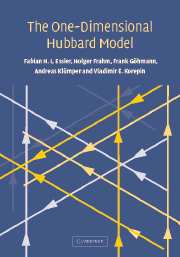Book contents
- Frontmatter
- Contents
- Preface
- 1 Introduction
- 2 The Hubbard Hamiltonian and its symmetries
- 3 The Bethe ansatz solution
- 4 String hypothesis
- 5 Thermodynamics in the Yang-Yang approach
- 6 Ground state properties in the thermodynamic limit
- 7 Excited states at zero temperature
- 8 Finite size corrections at zero temperature
- 9 Asymptotics of correlation functions
- 10 Scaling and continuum limits at half-filling
- 11 Universal correlations at low density
- 12 The algebraic approach to the Hubbard model
- 13 The path integral approach to thermodynamics
- 14 The Yangian symmetry of the Hubbard model
- 15 S-matrix and Yangian symmetry in the infinite interval limit
- 16 Hubbard model in the attractive case
- 17 Mathematical appendices
- References
- Index
3 - The Bethe ansatz solution
Published online by Cambridge University Press: 19 August 2009
- Frontmatter
- Contents
- Preface
- 1 Introduction
- 2 The Hubbard Hamiltonian and its symmetries
- 3 The Bethe ansatz solution
- 4 String hypothesis
- 5 Thermodynamics in the Yang-Yang approach
- 6 Ground state properties in the thermodynamic limit
- 7 Excited states at zero temperature
- 8 Finite size corrections at zero temperature
- 9 Asymptotics of correlation functions
- 10 Scaling and continuum limits at half-filling
- 11 Universal correlations at low density
- 12 The algebraic approach to the Hubbard model
- 13 The path integral approach to thermodynamics
- 14 The Yangian symmetry of the Hubbard model
- 15 S-matrix and Yangian symmetry in the infinite interval limit
- 16 Hubbard model in the attractive case
- 17 Mathematical appendices
- References
- Index
Summary
The bare existence of this book is due to the amazing fact that the solution of the stationary Schrödinger equation for the one-dimensional Hubbard model can be reduced to a set of algebraic equations, which is tractable in the thermodynamic limit. These equations will be derived in this chapter. We will call them the Lieb-Wu equations to honour E. H. Lieb and F. Y. Wu, who first obtained them [298]. The derivation is based on a method, called the nested (coordinate) Bethe ansatz, which goes back to the seminal articles of C. N. Yang [493] and M. Gaudin [154], who generalized earlier work [60, 296] on exactly solvable models to models with internal degrees of freedom.
The roots of the Lieb-Wu equations parameterize the eigenvalues and the eigenstates of the Hamiltonian of the one-dimensional Hubbard model. They encode the complete information about the model. These roots are not explicitly known in the general N-particle case. In the thermodynamic limit (N →∞), however, only the distributions of the roots in the complex plane matter, and many physical quantities can be calculated as solutions of linear or non-linear Fredholm type integral equations. Moreover, it is sometimes possible to use the Lieb-Wu equations in an implicit way even for finite N, e.g., in the proof of the SO(4) highest weight properties of the eigenstates in Sections 3.D and 3.F of the appendix or in the calculation of their norm in Section 3.5.
- Type
- Chapter
- Information
- The One-Dimensional Hubbard Model , pp. 50 - 119Publisher: Cambridge University PressPrint publication year: 2005

